|
|
|
Sort Order |
|
|
|
Items / Page
|
|
|
|
|
|
|
| Srl | Item |
| 1 |
ID:
170913
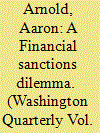

|
|
|
| 2 |
ID:
093273
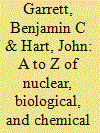

|
|
|
|
|
| Publication |
Lanham, Scarecrow Press, 2007.
|
| Description |
xxxvi, 261p.
|
| Series |
Historical dictionary of war, revolution and civil unrest; no. 33
|
| Standard Number |
9780810854840
|
|
|
|
|
|
|
|
|
|
|
|
Copies: C:1/I:0,R:0,Q:0
Circulation
| Accession# | Call# | Current Location | Status | Policy | Location |
| 054669 | 358.303/GAR 054669 | Main | On Shelf | General | |
|
|
|
|
| 3 |
ID:
101792
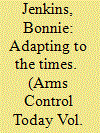

|
|
|
| 4 |
ID:
128127
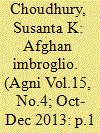

|
|
|
|
|
| Publication |
2013.
|
| Summary/Abstract |
The 11 September attacks in the United States caused NATO to invoke article 5 of the NATO charter for the first time in history. The article states that an attack on any member shall be considered to be attack on all. The invocation was confirmed on 4 October 2001 when NATO determined that the attacks were indeed eligible under the terms of North Atlantic Treaty Organisation, Eagle Assist and Operation Active Endeavour, a naval operation in the Mediterranean sea and is designed to prevent the movement of terrorists or weapons of mass destruction as well as to enhance the security of shipping the general which began on 4 October 2001.
|
|
|
|
|
|
|
|
|
|
|
|
|
|
|
|
| 5 |
ID:
144292
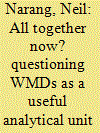

|
|
|
|
|
| Summary/Abstract |
The popular use of the term “weapons of mass destruction” (WMD) can be understood to imply a relationship between nuclear, chemical, and biological weapons proliferation insofar as it assumes that the separate weapons technologies can be usefully grouped into a single analytic category. This article explores whether WMD is actually a useful construct. It begins by reviewing the literature on nuclear, chemical, and biological weapons proliferation, including a recent study that sought to estimate the relationship between the pursuit and acquisition of these different weapons. It then explores some policy inferences that academics and policy makers may be tempted to draw from these studies, particularly regarding the Barack Obama administration's pursuit of deep nuclear reductions. It argues that many of these policy inferences are premature at best and misleading at worst. It concludes with a call for additional research into the causes and consequences of chemical and biological weapons proliferation, and a call for scholars to remain cautious in their desire to draw premature policy implications from their studies in order to be “policy relevant.”
|
|
|
|
|
|
|
|
|
|
|
|
|
|
|
|
| 6 |
ID:
066442


|
|
|
|
|
| Publication |
2000.
|
| Description |
p.59-75
|
|
|
|
|
|
|
|
|
|
|
|
|
|
|
|
| 7 |
ID:
078415
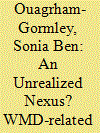

|
|
|
| 8 |
ID:
092926


|
|
|
|
|
| Publication |
2009.
|
| Summary/Abstract |
Since 2003, a series of Six-Party Talks has attempted to halt North Korea's nuclear development; nonetheless, considering the development of North Korean nuclear capability, the talks are often regarded as an ineffective framework. In order to break through such a situation, first and foremost it is imperative to understand the nature of North Korean foreign policy. In this paper, I argue that North Korean foreign policy can be explained by neoclassical realism: the international distribution of power is interpreted by its domestic political system based on the self-reliance (Juche) ideology and the supreme leader (Suryong) political structure, whose basis is its Confucian culture, and I argue that this perception has predominantly determined its foreign policy decision-making.
|
|
|
|
|
|
|
|
|
|
|
|
|
|
|
|
| 9 |
ID:
064976
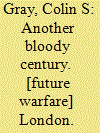

|
|
|
|
|
| Publication |
London, WeidenFeld and Nicolson, 2005.
|
| Description |
431p.Hbk
|
| Standard Number |
0297846272
|
|
|
|
|
|
|
|
|
|
|
|
Copies: C:1/I:0,R:0,Q:0
Circulation
| Accession# | Call# | Current Location | Status | Policy | Location |
| 049914 | 909.83/GRA 049914 | Main | On Shelf | General | |
|
|
|
|
| 10 |
ID:
066013
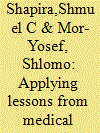

|
|
|
| 11 |
ID:
104990
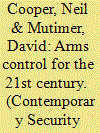

|
|
|
|
|
| Publication |
2011.
|
| Summary/Abstract |
In the past two decades there has been an extensive reconceptualization of security and its associated practices, but there has been scant attention to questions of arms and their control. This article, and those which follow, seek to start a conversation about the control of the means of violence. We begin by drawing on the metaphor of arms control as science fiction in order to highlight notable features of the classical arms control literature. The article then discusses the ways contemporary arms control practice has evolved from a Cold War focus on parity and mutual vulnerability to a global control architecture characterized by the pursuit of absolute security via an ever-expanding range of non-proliferation initiatives aimed at rogues, rebels and terrorists. Consequently, in its post-Cold War, post-9/11 mode, contemporary arms control practice has been transformed into a form of global counter-insurgency. We suggest that the term controlling the means of violence (CMV) better captures the wide range of control initiatives that can be deployed to limit the instruments of armed violence. Finally, we summarize the arguments set out in the rest of the special issue and outline the future directions for research and activism suggested both by the papers collected in this volume and the broader discussions in the conferences that gave rise to them.
|
|
|
|
|
|
|
|
|
|
|
|
|
|
|
|
| 12 |
ID:
018164
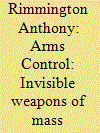

|
|
|
|
|
| Publication |
Sept 2000.
|
| Description |
1-46
|
|
|
|
|
|
|
|
|
|
|
|
|
|
|
|
| 13 |
ID:
001273
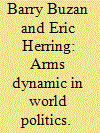

|
|
|
|
|
| Publication |
Boulder, Lynne Rienner, 1998.
|
| Description |
xiii,325p.
|
| Standard Number |
1-555-87-596-3
|
|
|
|
|
|
|
|
|
|
|
|
Copies: C:1/I:0,R:0,Q:0
Circulation
| Accession# | Call# | Current Location | Status | Policy | Location |
| 040807 | 327.1/BUZ 040807 | Main | On Shelf | General | |
|
|
|
|
| 14 |
ID:
132371
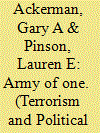

|
|
|
|
|
| Publication |
2014.
|
| Summary/Abstract |
In recent years, much of the literature on terrorist pursuits and use of unconventional weapons has focused on al-Qaeda and other Islamic extremist groups. Some scholars posit lone actors may differ from organizations when it comes to the observation that larger organizations are more likely to engage in chemical, biological, radiological, and nuclear (CBRN) activity, but leave this as an open question because of a prior lack of data on lone actors. Furthermore, new technologies and expanding networks may also spawn more deleterious lone actors, including what have been referred to as "super-empowered individuals." This article utilizes the Profiles of Incidents Involving CBRN by Non-State Actors Dataset and the Radiological and Nuclear Non-State Actors Database to illustrate the characteristics of CBRN pursuit by lone wolves and autonomous cells over time. Initial findings confirm the general perceptions that, historically, lone actors have engaged in cruder, smaller scale, and less frequent CBRN plots and attacks than their formal terrorist organization counterparts, but suggest that such actors do present a genuine threat, at least in terms of the potential for mass disruption. Additionally, while they share several similarities with more formal organizations, lone actors and autonomous cells tend to be motivated less by collective religious or ethno-nationalist concerns than larger organizations, focusing more on narrow or solipsistic drivers. Lone actors and autonomous cells also appear to largely calibrate their CBRN ambitions to their capabilities and their CBRN actions tend to receive better media coverage than formal terrorist organizations.
|
|
|
|
|
|
|
|
|
|
|
|
|
|
|
|
| 15 |
ID:
021521
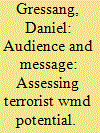

|
|
|
|
|
| Publication |
2001.
|
| Description |
83-106
|
|
|
|
|
|
|
|
|
|
|
|
|
|
|
|
| 16 |
ID:
073894
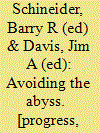

|
|
|
|
|
| Publication |
Westport, Praeger Security International, 2006.
|
| Description |
x, 430p.
|
| Standard Number |
0275990338
|
|
|
|
|
|
|
|
|
|
|
|
Copies: C:1/I:0,R:0,Q:0
Circulation
| Accession# | Call# | Current Location | Status | Policy | Location |
| 051645 | 327.1745/SCH 051645 | Main | On Shelf | General | |
|
|
|
|
| 17 |
ID:
097407
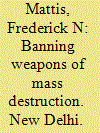

|
|
|
|
|
| Publication |
New Delhi, Pentagon Press, 2010.
|
| Description |
vi, 129p.
|
| Standard Number |
9780313365386
|
|
|
|
|
|
|
|
|
|
|
|
Copies: C:1/I:0,R:0,Q:0
Circulation
| Accession# | Call# | Current Location | Status | Policy | Location |
| 055051 | 327.1745/MAT 055051 | Main | On Shelf | General | |
|
|
|
|
| 18 |
ID:
106817
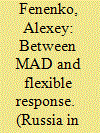

|
|
|
| 19 |
ID:
101553
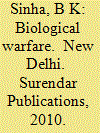

|
|
|
|
|
| Publication |
New Delhi, Surendar Publications, 2010.
|
| Description |
246p.
|
| Standard Number |
9789380014494, hbk
|
|
|
|
|
|
|
|
|
|
|
|
Copies: C:1/I:0,R:0,Q:0
Circulation
| Accession# | Call# | Current Location | Status | Policy | Location |
| 055599 | 358.38/SIN 055599 | Main | On Shelf | General | |
|
|
|
|
| 20 |
ID:
095975
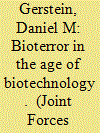

|
|
|
|
|
|
|
|